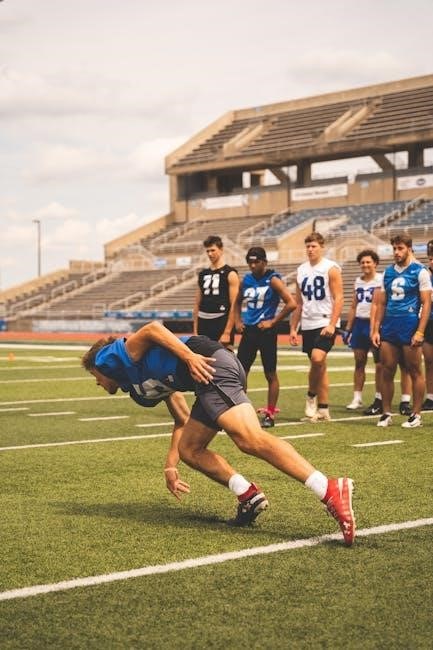
NFL workout programs are comprehensive training plans designed to enhance strength, speed, agility, and endurance for football athletes. These structured programs cater to rookies and veteran players, focusing on specific positional needs while improving overall performance; By integrating mental toughness, nutrition, and recovery strategies, NFL workout programs provide a holistic approach to achieving peak physical conditioning and game readiness.
Importance of Off-Season Training
Off-season training is critical for NFL athletes to rebuild, recover, and enhance physical performance. It addresses muscle imbalances, prevents injuries, and builds a foundation for strength and endurance. Structured programs ensure progressive overload, improving power and speed. This period also allows players to refine techniques, recover from in-season stress, and adapt to new strategies. A well-designed off-season program prevents burnout, ensuring peak readiness for the upcoming season. It’s a time for strategic development, making it essential for long-term success in professional football.
Benefits of a Structured Workout Program
Benefits of a Structured Workout Program
A structured workout program offers numerous benefits for NFL athletes, including improved physical performance, injury prevention, and mental preparation. It ensures a balanced approach to training, addressing strength, speed, agility, and endurance. Customized plans based on player needs and positional requirements maximize efficiency. Structured programs also enhance recovery, reducing the risk of overtraining. Additionally, they provide a clear roadmap for progression, helping athletes achieve specific goals. Mental toughness is bolstered through disciplined routines, preparing players for the demands of the season. Overall, a well-organized program is essential for peak performance, longevity, and success in professional football, ensuring athletes are physically and mentally prepared for competition.

Structure of an NFL Workout Program
NFL workout programs are structured into phases, focusing on building strength, endurance, and agility. Each phase incorporates specific exercises and training methods, ensuring progressive improvement in athletic performance.
Phases of the Program
NFL workout programs are divided into distinct phases, each targeting specific physical and skill development goals. Phase 1 focuses on foundational strength and endurance, incorporating lower body exercises like squats and lunges, while Phase 2 emphasizes power and speed through plyometrics and agility drills. Phase 3 concentrates on maximizing cardiovascular fitness and muscular endurance, preparing athletes for the demands of the season. Each phase lasts 3-4 weeks, allowing progressive overload and adaptation. The program also includes mental conditioning, nutrition advice, and recovery techniques, ensuring a well-rounded approach to improving performance and reducing injury risk for football athletes at all levels.
Key Components of the Program
NFL workout programs emphasize a blend of strength training, speed development, and flexibility exercises. They include compound lifts like squats and deadlifts to build raw power, alongside plyometric drills for explosiveness. Agility ladder exercises and shuttle runs enhance quickness and change-of-direction speed. Core strength is prioritized with exercises like planks and Russian twists. The programs also incorporate cardiovascular conditioning through high-intensity interval training (HIIT) to improve endurance. Additionally, nutrition and recovery strategies are integrated, ensuring athletes fuel their bodies optimally and recover efficiently. Each component is tailored to address specific performance needs, making the program comprehensive and effective for football athletes aiming to elevate their game.

Phase 1: Off-Season Training
Phase 1 focuses on stability and endurance, correcting muscle imbalances through core exercises and light strength training, building a foundation for more intense workouts.

Focus on Stability and Endurance
Phase 1 emphasizes building a strong foundation through stability and endurance exercises. Players engage in dynamic stretching, core stability drills, and light strength training to correct muscle imbalances. Focus areas include bodyweight exercises like planks, bird dogs, and single-leg stands to enhance balance and flexibility. Endurance is developed through tempo runs, high-repetition resistance band work, and low-intensity cardio sessions. These activities prepare athletes for more intense training phases ahead, ensuring proper movement patterns and reducing injury risk. The goal is to establish a base level of fitness that supports long-term performance and durability throughout the season.
Sample Exercises for Stability and Endurance
Key exercises for stability include planks, bird dogs, and single-leg stands to improve core strength and balance. Lateral lunges and step-ups target hip stability and flexibility. For endurance, tempo runs and high-repetition resistance band exercises are essential. Players also perform dynamic stretches like arm circles and leg swings to enhance mobility. Core stability drills such as Russian twists and leg raises further strengthen the midsection. These exercises ensure athletes build a solid foundation for more intense training phases, reducing injury risk and improving overall performance on the field.

Phase 2: Building Strength and Power
Phase 2 focuses on enhancing muscular strength and explosive power through targeted exercises like squats, deadlifts, and bench presses. Emphasizing lower body strength, upper body power, and core stability, this phase builds the foundation for peak performance.
Lower Body Strength Training
Lower body strength training is vital for NFL athletes, focusing on exercises like squats, lunges, and leg presses to build power and stability. These workouts target muscles in the legs, hips, and glutes, essential for explosive movements on the field. Athletes typically perform 4-6 sets of 4-8 reps, with adequate rest between sets to maximize strength gains. Techniques such as weighted lunges and step-ups are also incorporated to improve balance and functional strength. This phase ensures players can generate force efficiently, enhancing acceleration and endurance during games. Proper form and progression are emphasized to prevent injury and optimize performance.
Upper Body Strength Training
Upper body strength training focuses on building power and endurance in the chest, shoulders, and back. Exercises like bench presses, dumbbell rows, and shoulder presses are central, typically performed for 4-8 reps across 4-6 sets. These workouts enhance muscular stability and explosive force, crucial for blocking, tackling, and overall field performance. Progressive overload is emphasized to continuously challenge muscles, while maintaining proper form prevents injuries. Auxiliary exercises, such as lat pull-downs and incline presses, further target specific muscle groups. This phase ensures players can sustain contact and generate force effectively, contributing to their overall athletic performance and durability throughout the season.
Core Strength Exercises
Core strength exercises are vital for improving stability, balance, and overall athletic performance. Planks, Russian twists, and leg raises target the abdominals and obliques, enhancing rotational power and flexibility. These exercises often involve dynamic movements to mimic game scenarios, ensuring functional strength. Incorporating stability drills like pallof presses and bird dogs further strengthens the core muscles. Proper form and controlled movements are emphasized to prevent injury and maximize effectiveness. A strong core is essential for maintaining posture, generating force during tackles, and sustaining endurance throughout the game. These exercises are tailored to build resilience and explosive power, crucial for NFL-level competition.

Phase 3: Speed and Agility Development
This phase focuses on enhancing linear speed, acceleration, and agility through drills like sprints, ladder exercises, and cone setups, improving quickness and sharp directional changes for peak performance.
Linear Speed and Acceleration Drills
Linear speed and acceleration drills are essential for NFL athletes to enhance their ability to burst off the line and maintain top speed. These drills include hill sprints, which build explosive power, and field sprints focusing on proper running mechanics. Techniques like high knees and resistance band sprints are also utilized to improve acceleration. Additionally, exercises such as pogo jumps and sumo-to-RDL transitions emphasize explosive force production. These drills are structured to simulate game scenarios, ensuring players can rapidly accelerate and decelerate, giving them a competitive edge on the field. Proper form and recovery are emphasized to prevent injury and maximize performance gains.
Agility and Change-of-Direction Exercises
Agility and change-of-direction exercises are crucial for NFL athletes to improve quickness, reaction time, and the ability to navigate the field effectively. Drills such as ladder drills, cone exercises, and shuttle runs are commonly used to enhance footwork and agility. These exercises focus on rapid directional changes, mimicking game scenarios where quick pivots and sharp cuts are essential. Techniques like carioca drills and T-drills further develop lateral movement and balance. By incorporating these exercises, players can enhance their ability to explode out of cuts and maintain speed during transitions, giving them a decisive edge in competitive gameplay and overall performance.

Phase 4: Conditioning and Endurance
Phase 4 focuses on cardiovascular conditioning and endurance, ensuring players maintain stamina throughout games. High-intensity interval training (HIIT) and prolonged aerobic exercises build mental and physical resilience.
Cardiovascular Conditioning
Cardiovascular conditioning is a critical component of NFL workout programs, designed to improve heart health and increase stamina. Techniques include high-intensity interval training (HIIT), long-distance running, and dynamic exercises to enhance endurance. These workouts ensure players can sustain peak performance throughout the game. Proper warm-ups and cool-downs are emphasized to prevent injuries and optimize recovery. The goal is to build a strong aerobic base, enabling athletes to maintain energy levels in high-pressure situations. Cardiovascular training is tailored to meet the specific demands of football, ensuring players remain competitive and resilient during the season.
High-Intensity Interval Training (HIIT)
High-Intensity Interval Training (HIIT) is a cornerstone of NFL workout programs, focusing on short bursts of maximum effort followed by brief recovery periods. This method boosts both aerobic and anaerobic capacity, essential for football’s demands. HIIT workouts, such as sprint intervals or hill climbs, improve speed, agility, and endurance. They are tailored to mirror the stop-and-go nature of football, enhancing players’ ability to recover quickly between plays. By incorporating HIIT, athletes can increase their lactate threshold, delaying fatigue and maintaining high performance levels during games. This training is a key component of conditioning phases, ensuring players are prepared for the physical and mental challenges of the NFL season.

Nutrition and Recovery
Nutrition and recovery are vital for NFL athletes, ensuring optimal performance and muscle repair. Proper meal plans, hydration, and rest are essential to fuel intense workouts and aid recovery.
Meal Planning for Optimal Performance
A well-structured meal plan is essential for NFL athletes to fuel their bodies for intense workouts and aid recovery. Balanced nutrition focuses on lean proteins, complex carbs, and healthy fats, tailored to individual player needs. Proper hydration is emphasized to maintain performance levels. Meals are timed to optimize energy during training and replenish nutrients post-workout. Avoiding processed foods and emphasizing whole, nutrient-dense options ensures peak physical condition. A sports dietitian often customizes plans to address specific goals, such as weight management or injury recovery, ensuring athletes perform at their best.
Recovery Techniques for Athletes
Recovery is a critical component of NFL workout programs, ensuring athletes maintain peak performance and prevent injuries. Techniques include cold-water therapy, compression garments, and hydration to reduce muscle soreness. Stretching and foam rolling are also emphasized to improve flexibility and blood flow. Proper sleep is prioritized, as it aids in muscle repair and mental rejuvenation. Nutrition plays a key role, with anti-inflammatory foods and supplements supporting recovery. Additionally, mindfulness practices like meditation can help athletes mentally recharge. These strategies collectively help NFL players recover efficiently, enabling them to train at high intensities throughout the season.

Mental Toughness and Game Strategy
Mental toughness is cultivated through visualization, mindset training, and film analysis, enabling players to stay focused and strategic under pressure, enhancing their game performance and decision-making skills.
Visualization and Mindset Training
Visualization and mindset training are essential for NFL athletes to build mental resilience. Techniques include visualizing game scenarios, focusing on positive outcomes, and developing a growth mindset. These practices help players stay composed under pressure, enhance focus, and improve decision-making. By integrating mindfulness and cognitive exercises, athletes can strengthen their mental game, leading to better performance on the field. Teams often incorporate these strategies into their workout programs to ensure players are mentally prepared for challenges, fostering a culture of confidence and peak performance.
Game Footage Analysis and Strategy
Game footage analysis is a critical component of NFL training, allowing players and coaches to study opponents, identify strengths and weaknesses, and refine strategies. By reviewing past performances, athletes can improve decision-making, anticipate plays, and optimize their execution. Coaches use this data to develop tailored game plans, ensuring alignment with team objectives. Footage analysis also aids in identifying areas for skill improvement and adjusting techniques to gain a competitive edge. This strategic approach enhances overall team performance and prepares players for diverse game scenarios, making it an indispensable tool in the NFL workout program.

Sample NFL Workout Program PDF
A comprehensive guide detailing structured workouts, training schedules, and nutrition advice for NFL athletes. This downloadable PDF provides a roadmap to enhance performance and achieve peak conditioning.
Overview of the PDF Guide
The NFL workout program PDF offers a detailed, 12-week training plan tailored for football athletes. It includes strength and conditioning exercises, nutrition advice, and recovery strategies. The guide emphasizes phase-based training, starting with stability and endurance, progressing to strength, power, and speed. Each workout is structured with specific exercises, sets, and reps. The PDF also covers mental preparation techniques and provides sample meal plans to optimize performance. Designed for both rookies and veterans, this guide ensures a well-rounded approach to achieving peak physical fitness and mental readiness for the NFL season. It serves as a complete resource for athletes aiming to excel at the highest level.
Downloadable Resources and Templates
The NFL workout program PDF includes downloadable resources such as customizable meal plans, workout logs, and progress tracking sheets. These templates help athletes stay organized and focused throughout their training journey. Additionally, the guide offers video tutorials demonstrating proper exercise techniques, ensuring athletes perform movements safely and effectively. Printable charts for tracking strength gains, speed improvements, and recovery metrics are also provided. These resources are designed to complement the workout program, offering a structured approach to achieving peak performance. By utilizing these tools, athletes can maximize their training efficiency and maintain accountability as they work toward their NFL goals.
Embracing an NFL workout program PDF is a transformative step toward elite football performance. By combining strength, speed, and mental resilience, athletes can unlock their full potential and achieve success on the field.
Final Thoughts on the NFL Workout Program
NFL workout programs are meticulously crafted to elevate athletes to their peak performance. These structured plans blend strength, speed, agility, and mental resilience, ensuring players are fully prepared for competition. The integration of proper nutrition and recovery techniques further enhances the effectiveness of the program. By following such a comprehensive regimen, athletes can achieve their goals, whether aiming for the NFL Combine or excelling in their current league. Consistency and dedication are key, making these programs a valuable resource for aspiring football professionals seeking to excel at the highest levels of the sport.
Encouragement to Start the Program
Embrace the NFL workout program as your pathway to excellence. This structured plan is designed to unlock your full potential, whether you’re a seasoned athlete or an aspiring rookie. With its focus on strength, speed, and agility, the program provides a clear roadmap to success. Consistency and dedication are essential, but the results are transformative. By committing to this program, you’ll not only enhance your physical abilities but also mental toughness, setting yourself apart on the field; Take the first step today and join the ranks of elite football players who have achieved greatness through disciplined training and unwavering determination.